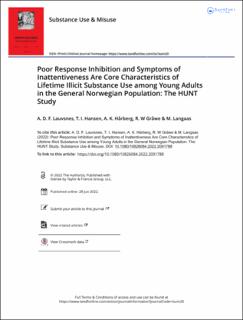| dc.contributor.author | Lauvsnes, Anders Dahlen Forsmo | |
| dc.contributor.author | Gråwe, Rolf W. | |
| dc.contributor.author | Hansen, Tor Ivar | |
| dc.contributor.author | Langaas, Mette | |
| dc.contributor.author | Håberg, Asta | |
| dc.date.accessioned | 2022-09-01T07:11:15Z | |
| dc.date.available | 2022-09-01T07:11:15Z | |
| dc.date.created | 2022-06-28T13:47:47Z | |
| dc.date.issued | 2022 | |
| dc.identifier.issn | 1082-6084 | |
| dc.identifier.uri | https://hdl.handle.net/11250/3014895 | |
| dc.description.abstract | Background
Impairments in neurocognitive functioning are associated with substance use behavior. Previous studies in neurocognitive predictors of substance use typically use self-report measures rather than neuropsychological performance measures and suffer from low sample sizes and use of clinical diagnostic cut offs.
Methods
Crossectional data from the HUNT4 Study (Helseundersøkelsen i Trøndelag) was used to study executive neuropsychological performance and self-reported measures of neurocognitive function associated with a history of illicit substance use in a general population sample of young adults in Norway. We performed both between group comparisons and logistic regression modeling and controlled for mental health symptomatology.
Results
Subjects in our cohort with a self-reported use of illicit substances had significantly higher self-reported mental health and neurocognitive symptom load. A logistic regression model with substance use as response included sex, commission errors and self-reported inattentiveness and anxiety as significant predictors. After 10-fold cross-validation this model achieved a moderate area under the receiver-operator curve of 0.63. To handle the class imbalance typically found in such population data, we also calculated balanced accuracy with a optimal model cut off of 0.234 with a sensitivity of 0.50 and specificity of 0.76 as well as precision recall—area under the curve of 0.28.
Conclusions
Subtle cognitive dysfunction differentiates subjects with and without a history of illicit substance use. Neurocognitive factors outperformed the effects of depressive symptoms on substance use behavior in this cohort. We highlight the need for using adequate statistical tools for evaluating the performance of models in unbalanced datasets. | en_US |
| dc.language.iso | eng | en_US |
| dc.publisher | Taylor and Francis | en_US |
| dc.rights | Attribution-NonCommercial-NoDerivatives 4.0 Internasjonal | * |
| dc.rights.uri | http://creativecommons.org/licenses/by-nc-nd/4.0/deed.no | * |
| dc.title | Poor Response Inhibition and Symptoms of Inattentiveness Are Core Characteristics of Lifetime Illicit Substance Use among Young Adults in the General Norwegian Population: The HUNT Study | en_US |
| dc.title.alternative | Poor Response Inhibition and Symptoms of Inattentiveness Are Core Characteristics of Lifetime Illicit Substance Use among Young Adults in the General Norwegian Population: The HUNT Study | en_US |
| dc.type | Journal article | en_US |
| dc.type | Peer reviewed | en_US |
| dc.description.version | publishedVersion | en_US |
| dc.source.journal | Substance Use & Misuse | en_US |
| dc.identifier.doi | 10.1080/10826084.2022.2091788 | |
| dc.identifier.cristin | 2035808 | |
| cristin.ispublished | true | |
| cristin.fulltext | original | |
| cristin.qualitycode | 1 | |

